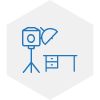Bachelor of Design (Communication Design)
Communication Design is a creative design process, with a concept at its core and an intent to entertain or educate. Aided by textual and visual messaging, the communication design process enables intuitive learning and understanding of ideas. By controlling colour, type, movement, symbols and images, the communication designer creates and manages the production of visuals designed to inform, educate, persuade and entertain the audience.

For Individuals...
who like to communicate visually and solve problems creatively using visual skills. It provides them with the necessary skills and thought processes to enhance these skills.

Looking for...
learning visual strategies to communicate effectively and engage audiences. Anant provides students to exposure various communication media which involve graphic design, animation, film-making and others.

To become...
- Graphic Designer
- Entrepreneur
- Advertising Professional
- Animator
- Content Creators
- Communication Designer
- Behavioural Change Communicators
Programme Highlights

Multidisciplinary

Graphic Design

Photography
Filmmaking

Illustration

Animation
About the Programme
- Semester 3
- Semester 4
- Semester 5
- Semester 6
- Semester 7
- Semester 8
Semester 3
Communication design students undergo a common foundation programme for the first year. In the third semester, students gain exposure to graphic design and an introduction to animation, film and interaction design as well. The student can then make an informed choice and focus on Graphic design, Illustration, Photography, Animation or Film making.
- Visual Design
- Basic Typography
- Basic Photography
- Design Process
- History of Graphic Design
- Colour Theory
Semester 4
Students learn skills in the dynamic media with motion graphics, photography using studio lights and large format photography. They also learn about signs, symbols and theory of communication before venturing into logo and identity design.
- Visual Design
- Semiotics
- Communication Theory
- Identity Design
- Advanced Photography
- Motion Graphics
Semester 5
Students learn about Indic typography and type design, observe and experiment with various printing techniques and design publications. The semester also introduces them to the basics of Interaction Design and how graphics can enhance interiors and exteriors. They also apply their learning to create a campaign for a social cause.
- Advanced Typography
- Print & Production Methods
- Publication Design
- Interaction Design
- Design for Social Impact
- Environmental Graphics
Semester 6
Students learn about human visual capabilities, strategies to make complex data presentable and understand the intricacies of packaging. The courses expose students to the basics of animation and principles of success in the profession.
- Visual Ergonomics
- Professional Practice & Design Management
- Data Visualisation
- Packaging Design
- Basic Animation
- Summer Internship
Semester 7
Students address complex problems through systems thinking and find ways of making their practice more planet-friendly. They learn to pursue research, write a paper, make short films from scratch and study about methods and materials of way-finding design. Students explore domains like Augmented Reality(AR), Virtual Reality(VR) and Mixed Reality(MR) as well.
- Research paper
- Systems Thinking
- Sustainable Graphic Design
- Signage & Way-finding
- Short film making
- Immersive media design
Semester 8
Students take up a graduation project, which can be self-initiated, faculty-suggested or offered by the industry. Students learn to apply their acquired skills and find their niche in the domain while learning project management skills.